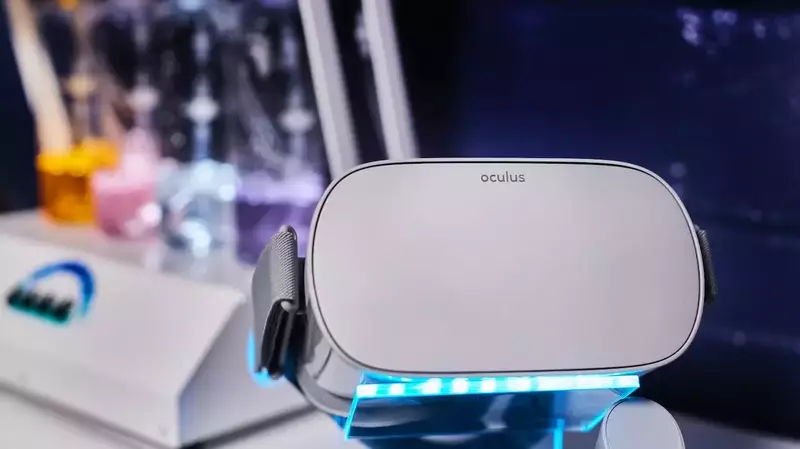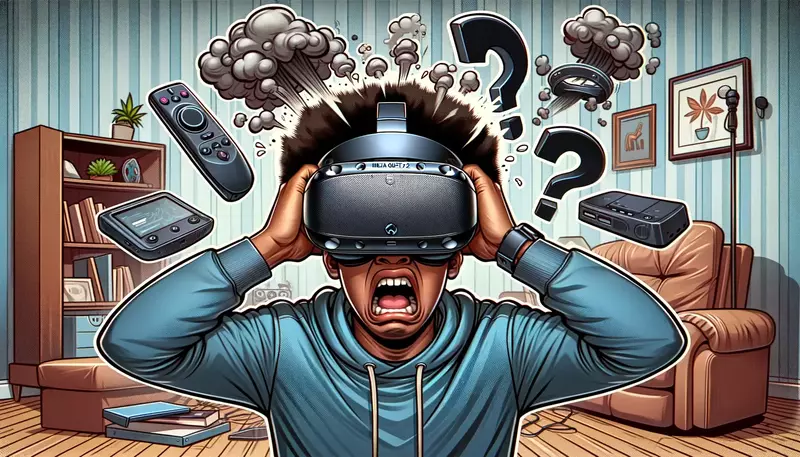This site contains affiliate links to products, and we may receive a commission for purchases made through these links.
The Oculus link is a great way to connect your Meta Quest to your PC and play games. However, some people have been having issues with it, namely lag. If you’re one of those people, don’t worry, you may wonder why your Oculus Link keeps lagging and how you can fix this.
Your Oculus link can lag because of high display options such as refresh rate and render solution. Lagging can also be caused by an incompatible PC or laptop, outdated windows, and bad graphics. Setting your sound output to your Oculus headset is also a common cause of lagging.
In this blog post, I will discuss the causes of lag and provide some tips on how to fix it.

Why Is My Oculus Link Lagging?
The following are some potential causes of lag:
1. High Display Options
The Oculus link requires a high display to work properly. If you’re using the link on a lower setting, it’s likely that you will experience lag. You can use the Oculus desktop app to fine-tune your display settings, such as refresh rate and render resolution.
Doing this may lead to a higher framerate and lower latency.
The recommended refresh rate is 72Hz, but you may want to experiment with lower or higher refresh rates to see what works best for you. This can sometimes lead to a laggy display.
2. Bad Graphics Card
Your graphics card may also be a potential cause of lag. The Oculus link requires a graphics card that is compatible with Direct X 11 or higher.
You can check your graphics card by going to “Settings” and then “System.”
If you’re not running the latest version of your graphics card, you may experience lag. Updating your drivers may help with this issue.
3. Incompatible PC or Laptop
If you’re using an incompatible PC or laptop, it’s likely that you will experience lag. The Oculus link is only compatible with certain types of PCs and laptops. Ensure your PC or laptop meets the minimum specifications required for the Oculus link.
The recommended specs for the Quest are an Intel i-core processor, NVIDIA GTX 1050 Ti graphics card, and at least eight gigs of RAM.
4. Outdated Windows
If you’re using an outdated version of windows, it’s likely that you will experience lag.
The Oculus link requires the latest version of windows to work properly.
You can update your windows by going to the settings app and clicking on update & security. From there, click on check for updates and install any that are available.
5. Sound Output
If you’re using the wrong sound output, it’s likely that you will experience lag. The Oculus link requires the use of an Oculus headset in order to work properly.
You can check if your sound output is set to your Oculus headset by going to the settings app and clicking on sound.
From there, click on manage sound devices and ensure your Oculus headset is set as the default device.
READ MORE! 18 Tips & Tricks For Oculus Quest 2 (You Need To Know!)
How To Fix the Oculus Link Lagging Problem
Now that we’ve gone over some of the potential lag causes let’s discuss how to fix it.
Ensure Your PC/Laptop is Oculus Compatible
Some PCs and laptops aren’t powerful enough to run the Oculus link smoothly. Make sure your computer meets the recommended specs for the Quest.
The Oculus Link requires a powerful PC to run properly, so if your machine isn’t up to snuff, that could cause the lag.
Ensure that your PC has at least an NVIDIA GTX 1050 Ti or an AMD Radeon RX 470 graphics card and a CPU that’s at least an Intel Core i-54590 or an AMD Ryzen 1500X.
Update Your Drivers
If you’re not running the latest version of your drivers, you may experience lag. You can update your drivers by going to the settings app and clicking on update & security.
From there, click on check for updates and install any that are available.
It’s important to keep your drivers up-to-date because they often include fixes for bugs that could cause lag.
Reinstall The Oculus Link Software
If you’re still experiencing lag, try reinstalling the Oculus link software. To do this, go to the settings app and click on device.
From there, click on Uninstall and confirm by clicking Uninstall.
Once the software has been uninstalled, restart your computer and go to the Oculus website to download and install the latest version.
Perform a Speed Test
If you’re still experiencing lag, try performing a speed test. To do this, go to the settings app and click on network & internet.
From there, click on status and then click on run the speed test.
This will help you determine if your internet connection is the cause of the lag. If it is, you may need to upgrade your internet package or switch to a different provider.
Use a Wired Connection
If you’re still experiencing lag, try using a wired connection.
To do this, go to the settings app and click on device. From there, click on USB and then select Use a Wired Connection. This will help you determine if your wireless connection is the cause of the lag.
If it is, you may need to switch to a different wireless router or use a different wireless network.
Factory Reset Your Oculus Quest
If you’ve tried all of the above and you’re still experiencing lag, you may need to factory reset your Oculus Quest.
To do this, go to the settings app and click on device. From there, click on reset and then select Factory Reset.
This will reset your Quest to its default settings and may help fix the lag issue.
READ MORE! How Do You Factory Reset Your Meta Quest 2? (Solved!)
Lower the Oculus Link Output Resolution
The Oculus Link can output up to a resolution of 2880×1600, but you may need to lower the resolution if you’re experiencing lag.
To do this, go to the settings app and click on device. From there, click on display and then select a lower resolution.
You may also need to lower the Oculus Link output frame rate if you’re still experiencing lag.
To do this, open up the Oculus app on your PC and go to Settings > General > Resolution. From there, you can lower the resolution until the lag goes away.
Change the Power Management Mode
Another thing you can try is to change the power management mode of your USB ports.
To do this, open up Device Manager on your PC and find the USB Root Hubs.
Right-click on each one and select Properties > Power Management. From there, uncheck the box that says, “Allow the computer to turn off this device to save power.”
Try Testing with Oculus Games First
If you’re still experiencing lag, try testing with Oculus games first. To do this, go to the settings app and click on device. From there, click on apps and then select Oculus Games.
This will help you determine if a specific game or app causes the lag. If it is, you may need to contact the game developer or app to report the issue.
Disable USB Power Saving and Select Suspend Mode
A significant amount of data is transferred from your PC to your Oculus Quest 2 headset using Oculus Link and VR gaming.
In fact, there is so much data that it is compressed before being sent over your USB port and cable, and then decompressed once it reaches your Quest 2.
Oculus Link is actually rather particular about this, so you want your USB ports to be operating at full power at all times to accommodate it.
There are numerous instances where Windows USB optimization methods lead to various hitches and performance problems.
We recommend that you disable USB power saving and select the “Suspend” mode for your Oculus Link connection in Windows.
To do this, go to Settings > Devices > USB, and then select “Disable Power Saving Mode” for both the Controller and Headset options. You should also set the “USB Selective Suspend Setting” to “Disabled” in your Power Options.
You can find these settings by going to the Start Menu, typing “power options,” and then selecting the “Change power-saving settings” option.
Then, click on the “Change advanced power settings” link.
In the Advanced Settings menu, expand both the USB Settings and USB selective suspend setting options and set them both to “Disabled.”
Restart Your Oculus Quest and PC
Finally, if you’re still experiencing lag, try restarting your Oculus Quest and PC. To do this, go to the settings app and click on device. From there, click on updates and then select Restart.
Once your Quest has restarted, try running Oculus Link again and see if the lag is gone. If it is, then great! If not, then you may need to contact Oculus support for further assistance.
Final Thoughts
Your Oculus link may lag because of high display options, outdated windows, incompatible or damaged USB cables, or other software that is hogging your resources.
To fix this, try changing the power management mode of your USB ports, testing with Oculus games first, checking for firmware updates, disabling USB power saving and selecting suspend mode, or restarting your Quest and PC.
I hope this article helped you fix the lag issue with your Oculus Link.
!! For more information about the different VR headsets on the market, check out this product specification list.

Espen
Espen is the Director of PursuitMeta and has written extensively about Virtual Reality and VR Headsets for years. He is a consumer product expert and has personally tested VR Headsets for the last decade.




Leave a Reply